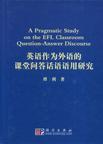英语作为外语的课堂问答话语语用研究
2008-5
科学出版社
傅利
188
30多年前年两位英国语言学家sinclair和COUl廿lard对课堂上的言语活动进行了分析,后来他们把自己的研究结果写成了一部著作并于1975年由牛津大学出版社出版,那是话语分析这个研究领域中早期一部颇有影响的作品——Towards an Analysis of Discourse。两位作者以收集到的课堂言语活动语料为基础,对课堂话语的构成作出了描述,并提出了一个多层的构成模式。不过他们当年对课堂话语所做的研究大体上是描述性的,是静态的。此后随着语用学这一新生领域的产生和壮大,语言研究进入了一个言必称语用的时代。自然,话语分析家也开始把语用融入自己的研究中去了。 哈尔滨工业大学傅利教授撰写的《英语作为外语的课堂问答话语语用研究》这部专著便是这个研究领域的成果之一。它的标题明白无误地告诉我们它研究的对象是什么,它研究的视角是什么。和30多年前两位英国学者的研究相比较,傅利教授的研究和他们的研究有相同之处,它们两者都以课堂话语为对象,两个研究都是描述性的;但是它们之间又有很大的不同,那就是前者是静态的,后者是动态的。后者的动态性是由它的研究视角决定的,因为它是对课堂问答话语所做的语用研究,而这一研究视角在30多年前恐怕还没有完全进入两位英国学者的视野。用语用这个视角去观察一个看似熟知的现象,我们可以看到许多我们原先所看不到的东西。这正是这部专著的意义和价值所在。作者通过实录课堂教学情景,对课堂里师生之间问答这一特定的话语活动做了描述,但作者并没有就此止步,她接着应用语用学的一系列理论对这个话语活动进行了动态的分析。除了对教师的问题和学生的回答的表面形式、类型和构成作了描述之外,她还对问题的功能、回答的内涵等语用侧面作了分析。
英语课堂教学需要很多语言交流活动,即课堂言语互动。课堂教学的言语互动主要体现在师生言语互动上,而这种言语互动又往往通过问与答的形式来完成。本书在运用话语分析的相关理论对课堂问答话语进行静态研究的同时,重点运用语用学的主要理论,诸如言语行为、语用前提、合作原则、礼貌原则等,对英语作为外语的课堂问答话语进行了动态研究。 语用学研究的是特定语境中的特定话语。在外语课堂教学这一具体语境中,教师的话语角色与他们的社会角色既相一致又相矛盾,这种矛盾统一在问答话语中得到充分的体现。一方面教师通过提问、反馈控制课堂话语和话轮;另一方面教师采用很多礼貌言语策略,鼓励学生参与课堂互动。在对课堂问答话语的理解与阐述上,英语作为外语的教学语境起着至关重要的作用。言语行为理论为课堂问答话语实施不同功能供了理论依据。提问可以使言成功有所为。即通过说出(言内行为)“提问”(次要言外行为)这一言语,间接发出指令(主要言外行为),使听话人按照指令行事(提问的言后行为);“回答 (言内行为),如解释、造句、朗读等(言外行为),同样是按照提问的间接指令在以言行事,满足提问不同的语用前提,达到提问以言致效的结果。在课堂回答话语中,师生均有违背合作原则的言语。教师违反数量准则,提供比问题所要求更详尽的话语是在利用回答增加言语输入;学生对数量准则、质量准则、关联准则或方式准则的违反,源于语言知识或技能的欠缺。在礼貌原则方面,师生也有许多与社会角色相脱离、与礼貌原则相悖的言语现象。这种对礼貌原則的违反,在课堂教学语境下有助于完成教学任务。 在讨论了课堂提问的八种形式、五种功能和回答的三种类型后,我们认为受课堂语境制约。学生作出的非期待回答、零回答与期待回答一样都对教学具有反馈意义。课堂问答话语除了在交流信息、维持人际关系上互相配合外,还在实施启发、检查、操练等教育功能和求知、解等探索功能方面相互作用。本研究根据真实、自然的课堂语料,总结了六种课堂问一答话语结构,并分别对起始、回应、反馈话目进行了考,认为IRF是课堂问一答话语的基本结构,其余四种(除IR结构外)结构是IRF结构的扩展结构。 本研究综合运用了话语分析和语用学两门学科的相关理论,采用定性分析的方法,以两种课型课堂教学语料为素材,对课堂问答话语进行了从静态到动态的实证研究,揭示了EFL教学中问与答言语互动的真实情况。本书从教师的权威性与学生的自主性、提高学生话语输出的质量与数量、反馈话目对学生学习动机和言语准确性的作用,以及培养学生语用能力四个方面讨论了问答话语互动对EFL教学的指导作用。这些结合英语教学实际的建议性意见将会对我国的英语教学具有很大的指导意义。
序AcknowledgementsAbstract内容提要Chapter I Introduction 1.1 Objectives of the Study 1.2 Rationale for the Study 1.3 Methodology and Data for the Study 1.3.1 Methodology 1.3.2 Data collection 1.3.3 Data description 1.3.4 Limitations in data collection 1.4 Outline of the BookChapter 2 Review of Discourse Analysis 2.1 Discourse Analysis 2.1.1 Early attempts 2.1.2 Sociological approach 2.1.3 Sociolinguistic approach 2.2 Critical Discourse Analysis 2.2.1 Discourse as power/knowledge 2.2.2 Discourse as social practice 2.2.3 Discourse as (re) production of dominance 2.2.4 Critique 2.3 Classroom Discourse Analysis 2.3.1 Hierarchical rank model 2.3.2 Instructional phase 2.3.3 Language classroom research 2.3.4 Critical analysis of classroom discourse 2.3.5 Classroom question and answer research SummaryChapter 3 Pragmatic Theories for the Study 3.1 Context 3.1.1 What is context? 3.1.2 The context-bound study 3.1.3 The context-bound discourse 3.2 Speech Act Theory 3.2.1 Speech acts 3.2.2 Illocutionary acts 3.2.3 Questions and answers as illocutionary acts 3.2.4 Questions as indirect directives 3.2.5 Questions and answers as indirect speech acts 3.3 Interpersonal Rhetoric 3.3.1 Cooperative principle (CP) 3.3.2 Politeness principle (PP) 3.3.3 Questions as face-threatening acts? 3.3.4 Answers and silence as face-losing acts? SumaryChapter 4 Questions in the EFL Classroom 4.1 Forms of Questions 4.1.1 General questions 4.1.2 Special questions 4.1.3 Alternative questionsChapter 5 Answers in the EFL ClassroomChapter 6 Question-Answer Structures ing the EFL ClassroomChapter 7 ConcclusionBibliographyAppecdices
1.3.4 Limitations in data collection There are some limitations in the data collection.Firstly:the present study was based on the tape-recording of two kinds of classes:with no interview and questionnaire being conducted.Secondly,the data were collected through tape-recording of the class,ignoring bodylanguage,such as facial expressions:gestures:etc.,of the subjects.Thirdly:a small amount of the recording was unintelligible and had tobe left alone.These limitations might to some extent affect the data forthe present classroom discourse analysis. 1.4 Outline of the Book This book is composed of seven chapters.Chapter One provides ageneral introduction to the current research:in which the objectives:the rationale:the methodology and data for the research are stated.Chapter Two presents a brief review of the literature regardingprevious studies of discourse analysis.This chapter introduces theachievements made in discourse analysis:critical discourse analysisand classroom discourse analysis.Chapter Three lays the pragmaticbasis for the research.The contributions of some key theories ofpragmatics:such as speech act theory:indirect speech act theory:presupposition:cooperative principle and politeness principle,areinvestigated and their application in classroom question-answerdiscourse is discussed with the collected data.Chapter Four dealswith the questions in the classroom,introducing the forms ofquestions:relating the features of teacher’S question and discussing itsfunctions:particularly its functions in teaching and learning.ChapterFive addresses the types of answers in relation to the questions.Chapter Six is devoted to the interplay of the question-answerdiscourse on the teacher-student interaction in the EFL classroom.After the demonstration of question-answer structures

英语课堂教学需要很多语言交流活动,即课堂言语互动。课堂教学的言语互动主要体现在师生言语互动上,而这种言语互动又往往通过问与答的形式来完成。本书在运用话语分析的相关理论对课堂问答话语进行静态研究的同时,重点运用语用学的主要理论,诸如言语行为、语用前提、合作原则、礼貌原则等,对英语作为外语的课堂问答话语进行了动态研究。
很好。适合小孩阅读。
还好,全英文,不过确实是专著。值得尊敬。
一本学术书用于参考不错不错